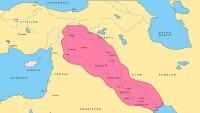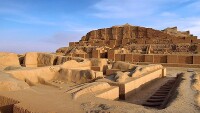巴比倫尼亞(Babylonia)亞洲西南部幼發拉底河谷的古代文化地區。這一地區原來分成兩個部分,一是東南部的蘇美爾,一是西北部的阿卡德,西元前2000年以後首次被阿莫里特人征服,由於漢穆拉比,巴比倫尼亞成為一個強盛的帝國。

巴比倫尼亞
亞洲西南部幼發拉底河谷的古代文化地區。這一地區原來分成兩個部分,一是東南部的蘇美爾,一是西北部的阿卡德,西元前2000年以後首次被阿莫里特人征服,由於漢穆拉比,巴比倫尼亞成為一個強盛的帝國。但他死後,帝國也隨之衰落。來自東部山區的喀西特人掌握政權,建立一個延續四百年的王朝。埃蘭征服巴比倫尼亞(約西元前1157年)后,隨著一連串戰爭后建立了新的王朝,其中最傑出的國王是尼布甲尼撒一世(Nebuchadnezzar I,約西元前1124~西元前1103年在位)。在他之後發生了
亞述、阿拉米(參閱Aramaeans)和加爾底亞為爭奪巴比倫尼亞展開一場三角鬥爭。從西元前9世紀起到西元前7世紀下半葉亞述帝國滅亡止,統治巴比倫尼亞的多半為亞述國王。西元前7世紀至西元前6世紀時,加爾底亞人
尼布甲尼撒二世創造了巴比倫尼亞最輝煌也是最後一個鼎盛的時期,他征服了敘利亞和巴勒斯坦,還重建首都巴比倫。西元前539年波斯居魯士大帝和西元前331年亞歷山大大帝先後佔領巴比倫尼亞。這個地區後來逐漸被放棄。

巴比倫尼亞
Ancient country, Euphrates River valley, South Asia. The area was divided into Sumer (in the southeast) and Akkad (northwest) when the first Babylonian line of Amorites took power after 2000 BC, largely because of Hammurabi (c. 1790-1750). The empire declined after his death; the Kassites from the east eventually assumed power (c. 1595) and established a dynasty that lasted 400 years. After Elam conquered Babylonia (c. 1157 BC), a series of wars established a new Babylonian dynasty whose outstanding member was Nebuchadnezzar I (r. 1124?-1103 BC). Following his rule, a three-way struggle developed among Assyria, Aram (see Aramaeans), and Chaldea. The Assyrians ruled the area most frequently in the 9th-7th century BC. In the 7th-6th century BC the Chaldean Nebuchadnezzar II instituted the last and greatest period of Babylonian supremacy, conquering Syria and Palestine and rebuilding Babylon, the capital city. Conquered in 539 BC by the Persian Cyrus the Great, and in 331 BC by Alexander the Great, the area was later gradually abandoned.



